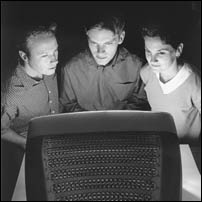![]()
![]()
![]()
![]()
![]()
![]()
Introducing the
All-New www.berkeley.edu
Revamped Gateway to World's Most-Visited Educational Web Domain Makes its Digital Debut
By Cathy
Cockrell, Public Affairs
Posted April 12, 2000
|
|
|
Rebuilt from the ground up by the Public Affairs Web team, with recommendations from the campus World Wide Web Steering Committee, the site features a reorganized and freshly designed home page; "spotlights" on important announcements, popular Berkeley Web sites and timely campus news; and an online "conceptual" tour of campus, similar to a view book. A text-only feature will make the site more accessible to those with visual disabilities or slow computers.
"The new Berkeley gateway site provides a very dynamic and exciting way to access the rich resources of the Berkeley campus," says Vice Chancellor James Hyatt, Web steering committee chairman.
Users will also find an A-to-Z roster of links to all 600 registered campus sites, says Public Affairs Web Director Andrew Baldock, and a search field on every page to help them find what they're looking for.
"Our single biggest challenge was providing a variety of pathways that work well individually and as a whole," notes Web Analyst Brad Falconer. "That's the criteria we will be judged on."
Media Metrix, a firm that measures Internet audience for the advertising industry, estimates that the berkeley.edu domain gets 1.7 million unique visitors per month -- making it the most-used educational Internet domain in the world. That figure does not include repeat visits by the same person.
|
|
"Our single biggest challenge was providing a variety of pathways that work well individually and as a whole. That's the criteria we will be judged on."
-
Web Analyst Brad Falconer |
The campus's previous Internet gateway launched at the end of what Baldock calls the "second generation" of Internet design, which concentrated on good looks and special effects. Contemporary Web sites, including the new Berkeley site, "pay attention first and foremost to information and functionality, while retaining good visual design," he said.
The Web team started the redesign by researching how the Berkeley site was being used and what frustrations users were encountering. It reviewed thousands of e-mail messages sent to the Web master, analyzed data collected through focus groups, and researched the terms that users have entered in the Cha-Cha search engine in their quest for hard-to-locate campus Web sites.
"It's hard to find things on the old site," Baldock says.
To make it easier to find information, the team developed 12 categories of information for the home page. They include, for example, new links to sports, "Applying to Berkeley," and all things administrative.
Information on Berkeley research initiatives will be easier to locate, using a page that provides links to nearly 200 research-related campus sites.
In the past, those looking for Cal Performances's stellar line-up of cultural events needed the intuition, or luck, to select "Departments" off the home page, then "Other Campus Links." The new gateway leads users, by a more logical path -- from the home page to "Libraries, Museums & Arts" -- to Cal Performances.
The site is also designed to be as "democratic" and accessible as possible.
"We didn't use technology that requires a really fast connection or a really expensive computer," says Falconer. "Many Web sites are almost unusable for those with visual impairments."
Soon after it began the redesign project a year and half ago, the Web team toured Berkeley's Disabled Students Program. There, a blind student demonstrated how a speech synthesizer reads Web page content to the sight impaired. Many sites, particularly those using a lot of cutting-edge bells and whistles, became completely garbled and unusable.
Visually impaired users who sign on to the new campus site will get an auditory message that takes them directly to a text-only version easily interpreted by their speech reader or Braille duplicator systems.
In the future, the Web team plans to add additional enhancements to the site, including a redesigned campus map, improved search services for the campus calendar of events, and tools useful to campus Web publishers.
![]()
![]()
April 12-18, 2000
(Volume 28, Number 28)
Copyright 2000, The Regents of the University of
California.
Produced and maintained by the Office
of Public Affairs
at UC
Berkeley.
Comments? E-mail berkeleyan@pa.urel.berkeley.edu.
